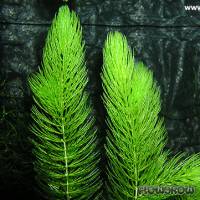



Ceratophyllum demersum, also known as hornwort or coontail, is a ubiquitous aquatic plant, a true cosmopolitan. It is found floating or anchored in the ground, in manifold stagnant to slow-flowing waterbodies. This plant has been used in aquaristics since the beginnings of the hobby.
C. demersum is in reality a collective name for a number of species, which can only safely be discerned from each other by the number of spines on their fruit. In the aquarium, these fruit do not form, as a rule.
The adaptation of Ceratophyllum to a life under water is extreme. Its inconspicuous flowers open under water, and the pollen from the male flowers gets to the female flowers through the water (hydrophily).
The cultivation of C. demersum is easy. This plant is completely rootless and grows equally well floating under the water surface or anchored on the ground. In literature, special rhizoid shoots are described that grow on shoots with contact to the substrate and anchor the plant by entering the ground. It is not quite clear yet whether this phenomenon also occurs in the aquarium.
Hornwort grows fast in soft to very hard water and adapts well to almost any kind of temperature. Those hornworts taken from nature in temperate climates are hardy in winter and thus are ideally suited for garden ponds. In autumn, the plants form short, compact shoots that sink to the ground to hibernate. When temperatures rise again in spring, they start growing.
Ceratophyllum in the aquarium does not require additional CO2, however, it enhances growth (which is very fast anyway). C. demersum is well-known for its ability to absorb nutrients very quickly, which makes it a great ally for battling algae. In addition, it produces a natural algae growth inhibitor.
Due to its enormously fast growth it has to be trimmed frequently in order to maintain its form.
C. demersum should be used in the background of the aquarium, where it forms nice and dense clusters. It has to be anchored on the ground at regular intervals by pressing the bases into the substrate or by fixing it to rocks and other anchors to prevent it from floating. All in all, this plant is better known as nutrient absorber than as a beautiful aquarium plant. However, it is an easy-to-grow plant especially for shrimp tanks that provides these animals with lots of places to hide and surfaces to graze on.
<a href="https://www.flowgrow.de/db/aquaticplants/ceratophyllum-demersum" target="_blank"><img alt="Ceratophyllum demersum" title="Ceratophyllum demersum" src="https://www.flowgrow.de/db/widget/aquaticplants/ceratophyllum-demersum" /></a>
[url=https://www.flowgrow.de/db/aquaticplants/ceratophyllum-demersum][img]https://www.flowgrow.de/db/widget/aquaticplants/ceratophyllum-demersum[/img][/url]
[widget=aquaticplants/ceratophyllum-demersum]Ceratophyllum demersum[/widget]